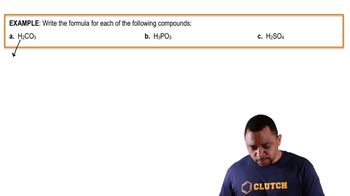Textbook Question
The following models represent the structures of binary hydrides
of second-row elements:
(a) Identify the nonhydrogen atom in each case, and write the molecular formula for each hydride.
106
views
 Verified step by step guidance
Verified step by step guidance



The following models represent the structures of binary hydrides
of second-row elements:
(a) Identify the nonhydrogen atom in each case, and write the molecular formula for each hydride.
Using the shorthand notation of Figure 22.9, draw the structure of the cyclic silicate anion in which four SiO4 tetrahedra share O atoms to form an eight-membered ring of alternating Si and O atoms. Give the formula and charge of the anion.
Suggest a plausible structure for the silicate anion in the mineral thortveitite, Sc2Si2O7.
Compare and contrast the properties of ammonia and phosphine.
In what forms is oxygen commonly found in nature?
Arrange the following oxides in order of increasing basic character: Al2O3, Cs2O, K2O, N2O5.